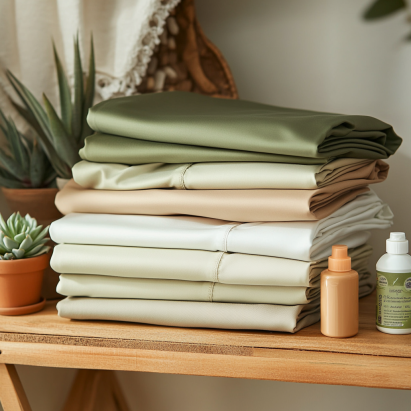Eco-Conscious Bedding: How to Choose Sustainable Sleep Essentials
By choosing eco-conscious bedding, you reduce environmental impact from water use, chemicals, and waste while enjoying high-quality sleep. These choices not only benefit the environment but also elevate your personal well-being through healthier materials and mindful living.
Key Takeaway
- Eco-conscious bedding reduces environmental harm and supports sustainable production across all stages of manufacturing and disposal.
- Look for certifications like GRS, BCI, and Oeko-Tex to ensure bedding meets trusted sustainability standards.
- Microfiber made from recycled plastics and organic cotton are excellent choices for balancing comfort, affordability, and eco-friendliness.
The Environmental Impact of Conventional Bedding
Most conventional bedding, particularly cotton-based options, comes with a heavy ecological price tag. Beyond what meets the eye—soft sheets and plush pillows—lies an industry deeply entangled with pesticide use, water overconsumption, and carbon emissions.
- Pesticides and Herbicides: Conventional cotton farming accounts for nearly 16% of global insecticide use despite occupying only 2.5% of farmland. These chemicals contaminate air, water, and soil and have been linked to health issues for farmworkers.
- Excessive Water Usage: Producing just one cotton sheet set can require up to 20,000 liters of water, especially when sourced from regions already experiencing water scarcity.
- Greenhouse Gas Emissions: Transportation, irrigation, and fertilizer use contribute to significant emissions. One kilogram of cotton can produce over 2 kilograms of CO2 emissions.
Switching to eco-conscious bedding made with more responsible practices is a small act that has a cumulative global benefit.

The Benefits of Eco-Conscious Microfiber Sheets
Microfiber sheets made from recycled materials offer an innovative solution for both comfort lovers and eco-warriors. These sheets provide a buttery-soft feel while giving plastic bottles a second life. It’s sustainability without compromising on style or sleep quality.
- Recycling Waste: Each set of recycled microfiber sheets can repurpose 30 to 40 plastic bottles, keeping them out of oceans and landfills.
- Lower Resource Usage: Compared to cotton, producing microfiber requires significantly less water and energy—making it a cleaner option from the start.
- Durability: Microfiber resists fading and fraying. It can last twice as long as some cotton alternatives, meaning less waste over time.
Microfiber sheets are ideal for those who want to align their lifestyle with low-waste values, especially in homes with kids or pets where durability matters.
Read our guide on sustainable bedding options

Choosing the Right Eco-Conscious Bedding
Shopping for eco-conscious bedding doesn’t have to be overwhelming. The key is to focus on credible certifications and quality that supports long-term use. Think of it as an investment in both your health and the planet’s future.
- Oeko-Tex Standard 100: This ensures the product is free of harmful substances often found in synthetic bedding, such as formaldehyde or heavy metals.
- Global Recycled Standard (GRS): This certification confirms not only recycled content but also verifies environmental and social practices in production.
- Better Cotton Initiative (BCI): Helps improve global cotton farming with safer, more ethical practices. Learn more
- Double-check fabric content—terms like “bamboo” may hide rayon unless verified as organic.
- Prioritize bedding with high thread counts and natural fibers for breathability and longevity.
- Choose brands that provide transparency in their sourcing and production chain.
Certified eco-conscious bedding provides peace of mind—you’re not only buying better sleep but also supporting healthier ecosystems and fair labor practices.

Caring for Your Eco-Conscious Bedding
Even the most sustainable bedding can lose its value if not cared for properly. Thoughtful maintenance preserves the integrity of eco-friendly fabrics and ensures their longevity—keeping them out of landfills longer.
- Use Eco-Friendly Detergent: Choose biodegradable and phosphate-free detergents to avoid introducing toxins into waterways.
- Avoid Fabric Softeners: These can coat fibers and reduce absorbency. Instead, use white vinegar in the rinse cycle for a natural alternative.
- Air Dry When Possible: Line drying saves energy and is gentler on fibers, extending their life and maintaining softness.
Creating an eco-conscious laundry routine is just as important as the bedding itself. Every small act reinforces your commitment to sustainability.

Affordable Eco-Conscious Bedding Options
Sustainability shouldn’t come at a premium—and fortunately, it doesn’t have to. Eco-conscious bedding is now available at a wide range of price points, especially with the right strategies.
- Sustainable Cotton: BCI-certified or organically grown cotton is now more accessible through major retailers and online eco shops.
- Recycled Materials: Microfiber bedding made from post-consumer plastics often costs less than traditional cotton and wears just as well.
- Sales & Bundles: Many sustainable brands offer welcome discounts, bundle deals, or loyalty rewards—making it easier to switch without breaking the bank.
Pro tip: Sign up for eco-brand newsletters to get early access to seasonal sales and sustainability tips!
More eco-friendly bedding ideas
Making an Impact with Your Bedding Choices
It’s easy to underestimate how everyday products like bedding affect the planet. But the truth is, your sheets and comforters are part of a larger environmental footprint—and you have the power to lighten it.
- Opt for Recycled Bedding Materials: Choosing products made from recycled polyester or upcycled fibers cuts down on landfill overflow and reduces demand for virgin materials.
- Choose Certified Sustainable Cotton: Supporting brands with BCI or organic cotton practices ensures better soil health, worker safety, and water conservation.
When multiplied across millions of households, these mindful bedding decisions create a ripple effect that supports cleaner, more responsible production globally.

Final Thoughts
Eco-conscious bedding is more than a home upgrade—it’s a commitment to sustainability, comfort, and ethical living. From minimizing waste to supporting better farming and labor practices, your bedding choices matter. The next time you tuck yourself in, you’ll know that your cozy bed also hugs the Earth back.
Explore more options at Cozy Bed Quarters and Curiously Conscious.
FAQ
- What is eco-conscious bedding?
- Eco-conscious bedding is made from recycled or sustainably sourced materials such as organic cotton or upcycled microfiber, reducing the product’s impact on the environment throughout its lifecycle.
- Are microfiber sheets environmentally friendly?
- Yes, especially when made from recycled plastic bottles. They offer a second life for plastic waste and require less water and energy to produce than traditional cotton.
- How can I ensure my bedding is sustainable?
- Look for certifications like GRS, BCI, and Oeko-Tex, review brand transparency, and prioritize long-lasting materials made through ethical practices.























